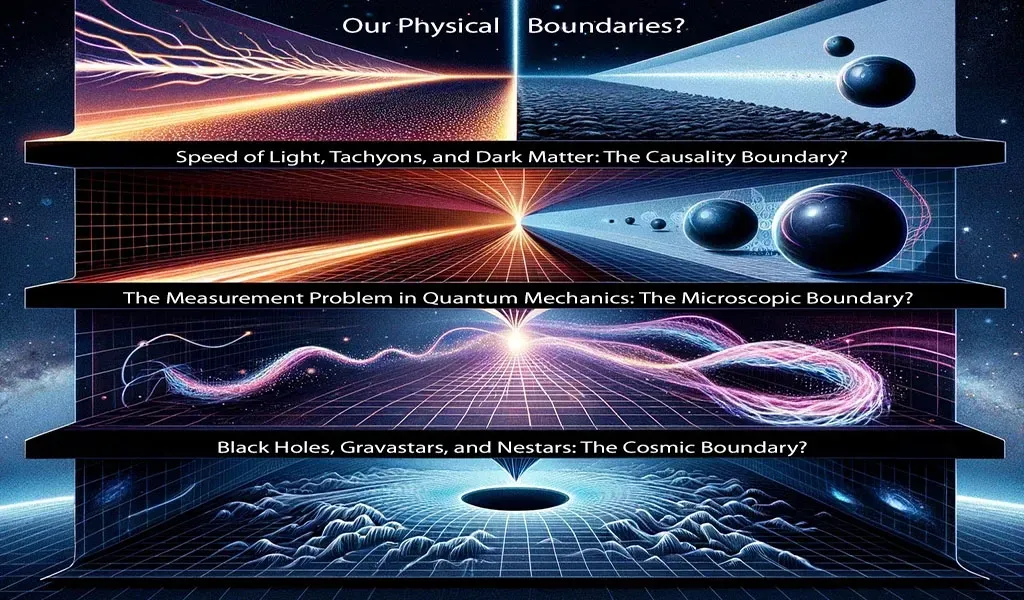Introduction
I recently came across a study in the Astrophysics preprint archive (arXiv:2403.13859) titled "Testing Tachyon-Dominated Cosmology with Type Ia Supernovae." Although the full comprehension of the theory and its implications eludes me, it echoes the notion of several "boundaries" within our conventional physics theories that have long intrigued me. Perhaps these are genuine limits that we simply cannot transcend in our physical realm. I am eager to hear your thoughts.
Speed of Light, Tachyons, and Dark Matter: The Causality Boundary
Einstein’s theory of relativity enshrines the speed of light as the ultimate velocity in the universe. Yet, it intriguingly allows for the theoretical possibility of tachyons, particles that could outpace light.
Tachyons
- Tachyons are postulated as particles capable of exceeding the speed of light, a feat unattainable for ordinary matter.
- While emerging from the framework of relativity theory, tachyons challenge established physical principles, particularly causality—the linkage between cause and effect.
Tachyons and Dark Matter
- Dark matter, an enigmatic substance, is thought to form a significant portion (85%) of the universe. Although invisible to us, its gravitational influence is observed in the dynamics of galaxies and other cosmic structures.
- Some theories speculate that tachyons might constitute components of dark matter, interacting so feebly with ordinary matter that they elude direct detection, potentially contributing to the gravitational phenomena ascribed to dark matter.
Causality Violation
- Should tachyons be capable of transmitting information faster than light, they would invert the causal order, engendering paradoxes. Yet, despite exhaustive researches, tachyons remain unverified.
The Question
- What is the essence of the ubiquitous physical constant c (the speed of light)? And of dark matter? Might they demarcate our reality from other conceivable realms?
Measurement Problem in Quantum Mechanics: The Microscopic Boundary?
Quantum mechanics governs the microscopic realm, with particles existing in states of superposition, encoded by wave functions. In contrast, the macroscopic world presents us with definite outcomes, the transition between these realms facilitated solely through the act of measurement—hence the measurement problem.
The Measurement Problem
- Superposition vs. Definite Outcomes: Quantum entities dwell in multiple states simultaneously, yet upon measurement, they appear decidedly localized.
- The Collapse Mystery: The process of measurement seemingly compels the wave function to 'collapse,' selectively realizing only one of the many potentialities, an occurrence yet to be elucidated within quantum mechanics.
Dominant Interpretations Several hypotheses attempt to resolve this enigma:
- Copenhagen Interpretation: Collapse is believed to occur spontaneously with measurement, sans an underlying mechanism.
- Many-Worlds Interpretation: Every potential outcome transpires, each in a distinct parallel universe.
- Decoherence Theory: Interaction with the environment disrupts a quantum system's coherence, ostensibly leading to wavefunction collapse and observable results in the larger world.
- Pilot Wave Theory (de Broglie-Bohm): Proposes the coexistence of particles and a guiding 'pilot wave' in the quantum realm, directing particles on predetermined trajectories.
- Hidden Variables Theories: Suggest unseen factors predetermine the outcomes of measurements, imparting a veneer of realism, though recent experiments (e.g., Bell tests) largely discount this view.
The Ongoing Debate
- Despite years of inquiry, none (except the last) of these interpretations has been definitively validated or invalidated, leaving the Measurement Problem as a profound mystery and a reminder of the limitations of our grasp on reality.
The Question
- Could the measurement problem represent a frontier between our macroscopic reality and the quantum world?
Black Holes, Gravastars, and Nestars: The Cosmic Boundary?
The Black Hole Big Bang Theory (BHBBT)
- The BHBBT postulates a profound linkage between black holes and the genesis of our universe, wherein a black hole’s intense gravitational pull in a "parent universe" could catalyze the formation of a new "daughter universe" through a singularity that acts as a birthing canal.
- As matter from the parent universe succumbs to the black hole, it transmutes into the energy and material constituents of our universe, in essence pouring forth in a cosmic genesis.
Gravastars and Nestars
- Gravastars, posited as theoretical alternatives to black holes, possess a core of dark energy surrounded by a conventional matter shell and lack the defining singularity.
- General relativity suggests the tantalizing possibility of gravastars nested within one another, forming a cascade of Nestars.
Connection
- Gravastars, if validated, could seamlessly integrate into the BHBBT framework, presenting the prospect of matter and energy traversing through them to seed new universes, mirroring the role of black holes in BHBBT.
- A concatenation of nested gravastars implies a potential serial emergence of universes.
The Question
- Does the black hole phenomenon delineate an actual boundary between our universe and an external expanse, should it exist?



Member discussion: